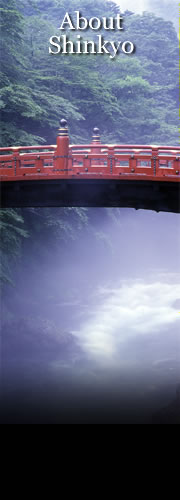| (1) A told foundation |
According to the records regarding Priest Shoto's establishment, its
foundation was possibly in the later Nara period. However, it is not
clear. The original figure of the bridge may be hanging bridge suspended
by natural plant.
|
|
(2) Appearance on the historical record
|
Shinkyo appeared in two books of travel in Muromachi era.
1. Kaikoku-zakki was written by Doukou Junkou, who was the successor of
Shougoin Temple. According to the article, the author visited Shinkyo in
1486.
2. Azumajino-tsuto was written by Saiokuken Souchou, who was the poet
specialized in linked poetry. According to the article, the author visited
Shinkyo in 1509. Shinkyo was already well known bridge at that time. The
bridge had no piers, and was a drawbridge judging from the article.
|
|
(3) Change from the traditional figure
|
Shinkyo changed its construction style in the 1636's reforming period of
Toshogu Shrine. Stone piers were added, and no decorations on the wooden
materials. Ordinary people were not allowed to use the bridge, and used
temporary bridge for passage.
|
| (4) After the reforming |
After that, Shinkyo had been repaired every 10 or 20 years, and become
decorated since 1792. For example, the decorations were vermilion and
black lacquered.
|
| (5) Modern history |
Shinkyo was washed out in 1902 when repairing.
Shinkyo was rebuilt in 1904 as it used to be.
Shinkyo was designated as the building, which needed special protection by
the law in 1908.
Shinkyo was re-designated as the national treasure in 1929.
Content of national treasure was revised in 1944.
|

